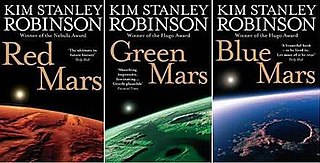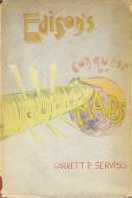
Mars, the fourth planet from the Sun, has appeared as a setting in works of fiction since at least the mid-1600s. Trends in the planet's portrayal have largely been influenced by advances in planetary science. It became the most popular celestial object in fiction in the late 1800s, when it became clear that there was no life on the Moon. The predominant genre depicting Mars at the time was utopian fiction. Around the same time, the mistaken belief that there are canals on Mars emerged and made its way into fiction, popularized by Percival Lowell's speculations of an ancient civilization having constructed them. The War of the Worlds, H. G. Wells's novel about an alien invasion of Earth by sinister Martians, was published in 1897 and went on to have a major influence on the science fiction genre.

The Mars trilogy is a series of science fiction novels by Kim Stanley Robinson that chronicles the settlement and terraforming of the planet Mars through the personal and detailed viewpoints of a wide variety of characters spanning almost two centuries. Ultimately more utopian than dystopian, the story focuses on egalitarian, sociological, and scientific advances made on Mars, while Earth suffers from overpopulation and ecological disaster.

A Princess of Mars is a science fantasy novel by American writer Edgar Rice Burroughs, the first of his Barsoom series. It was first serialized in the pulp magazine All-Story Magazine from February–July, 1912. Full of swordplay and daring feats, the novel is considered a classic example of 20th-century pulp fiction. It is also a seminal instance of the planetary romance, a subgenre of science fantasy that became highly popular in the decades following its publication. Its early chapters also contain elements of the Western. The story is set on Mars, imagined as a dying planet with a harsh desert environment. This vision of Mars was based on the work of the astronomer Percival Lowell, whose ideas were widely popularized in the late 19th and early 20th centuries.

Sleepers of Mars is a collection of early short stories by British writer John Wyndham, published after his death, in 1973 by Coronet Books.

The Ice Warriors are a fictional extraterrestrial race of reptilian humanoids in the long-running British science fiction television series Doctor Who. They were originally created by Brian Hayles, first appearing in the 1967 serial The Ice Warriors where they encountered the Second Doctor and his companions Jamie and Victoria. In Doctor Who, the Ice Warriors originated on Mars, which within the series narrative is a dying world. Their early appearances depict the Ice Warriors as attempting to conquer the Earth and escape their planet as early as Earth's Ice Age. A frozen group are discovered by an Earth scientific team, one of whom, Walters, dubs them 'Ice Warriors' in their first appearance. Despite this not being the name of their species, an Ice Lord later refers to his soldiers as Ice Warriors in the 1974 serial The Monster of Peladon. Similarly there is a fleeting reference to themselves as such in The Curse of Peladon. Although originally appearing as villains, subsequent appearances have depicted Ice Warriors that have eschewed violence and even ally themselves with the Doctor. They have also been featured in flashback and cameo appearances, in addition to appearing frequently in spin-off media such as novels and audio releases.

Protector is a 1973 science fiction novel by American writer Larry Niven, set in his Known Space universe. It was nominated for the Hugo in 1974, and placed fourth in the annual Locus poll for that year.

Robinson Crusoe on Mars is a 1964 American science fiction film directed by Byron Haskin and produced by Aubrey Schenck that stars Paul Mantee, Victor Lundin, and Adam West. It is a science fiction retelling of the classic 1719 novel Robinson Crusoe by Daniel Defoe. The film was distributed by Paramount Pictures and filmed in Technicolor and Techniscope.

Colonization or settlement of Mars is the theoretical human migration and long-term human establishment of Mars. The prospect has garnered interest from public space agencies and private corporations and has been extensively explored in science fiction writing, film, and art. Organizations have proposed plans for a human mission to Mars, the first step towards any colonization effort, but thus far no person has set foot on the planet, and there have been no return missions. However, landers and rovers have successfully explored the planetary surface and delivered information about conditions on the ground.

"A Martian Odyssey" is a science fiction short story by American writer Stanley G. Weinbaum originally published in the July 1934 issue of Wonder Stories. It was Weinbaum's second published story, and remains his best known. It was followed four months later by a sequel, "Valley of Dreams". These are the only stories by Weinbaum set on Mars.

Edison's Conquest of Mars is an 1898 science fiction novel by American astronomer and writer Garrett P. Serviss. It was written as a sequel to Fighters from Mars, an unauthorized and heavily altered version of H. G. Wells's 1897 story The War of the Worlds. It has a place in the history of science fiction for its early employment of themes and motifs that later became staples of the genre.

The idea of sending humans to Mars has been the subject of aerospace engineering and scientific studies since the late 1940s as part of the broader exploration of Mars. Long-term proposals have included sending settlers and terraforming the planet. Proposals for human missions to Mars have come from agencies such as NASA, CNSA, the European Space Agency, Boeing, and SpaceX. Currently, only robotic landers and rovers have been on Mars. The farthest humans have been beyond Earth is the Moon, under the Apollo program.

Flight to Mars is a 1951 American Cinecolor science fiction film drama, produced by Walter Mirisch for Monogram Pictures, directed by Lesley Selander, that stars Marguerite Chapman, Cameron Mitchell, and Arthur Franz.

Barsoom is a fictional representation of the planet Mars created by American pulp fiction author Edgar Rice Burroughs. The first Barsoom tale was serialized as Under the Moons of Mars in pulp magazine The All-Story from February to July 1912 and published compiled as a novel as A Princess of Mars in 1917. It features John Carter, a late-19th-century American Confederate veteran who is mysteriously transported from Earth to the dying world of Mars where he meets and romances the beautiful Martian princess Dejah Thoris. Ten sequels followed over the next three decades, further extending his vision of Barsoom and adding other characters.

Marooned on Mars is a juvenile science fiction novel written by American writer Lester del Rey. It was published by John C. Winston Co. in 1952 with illustrations by Alex Schomburg.

The War of the Worlds is a science fiction novel by English author H. G. Wells. It was written between 1895 and 1897, and serialised in Pearson's Magazine in the UK and Cosmopolitan magazine in the US in 1897. The full novel was first published in hardcover in 1898 by William Heinemann. The War of the Worlds is one of the earliest stories to detail a conflict between humankind and an extraterrestrial race. The novel is the first-person narrative of an unnamed protagonist in Surrey and his younger brother in London as southern England is invaded by Martians. It is one of the most commented-on works in the science fiction canon.

The Martian is a 2011 science fiction debut novel written by Andy Weir. The book was originally self-published on Weir's blog, in a serialized format. In 2014, the book was re-released after Crown Publishing Group purchased the exclusive publishing rights. The story follows an American astronaut, Mark Watney, as he becomes stranded alone on Mars in 2035 and must improvise in order to survive.
Stanley Bennett Hough was a British author of science fiction, for which he used the pseudonym Rex Gordon. He also published several novels under his own name.

The Massacre of Mankind (2017) is a science fiction novel by the British writer Stephen Baxter, a sequel to H. G. Wells' 1898 classic The War of the Worlds, authorised by the Wells estate. It is set in 1920, 13 years after the events of the original novel, as a second Martian invasion is chronicled by Miss Elphinstone, the ex-sister-in-law of the narrator of War of the Worlds. Baxter also wrote an authorised sequel to Wells' novel The Time Machine, called The Time Ships.

Project Mars: A Technical Tale is a science fiction novel by German-American rocket physicist, Wernher von Braun (1912–1977). It was written by von Braun in German in 1949 and entitled Marsprojekt. Henry J. White (1892–1962) translated the book into English and it was published later by Apogee Books (Canada) in 2006 as Project Mars: A Technical Tale, almost thirty years after von Braun's death. The original German text remains unpublished.

















